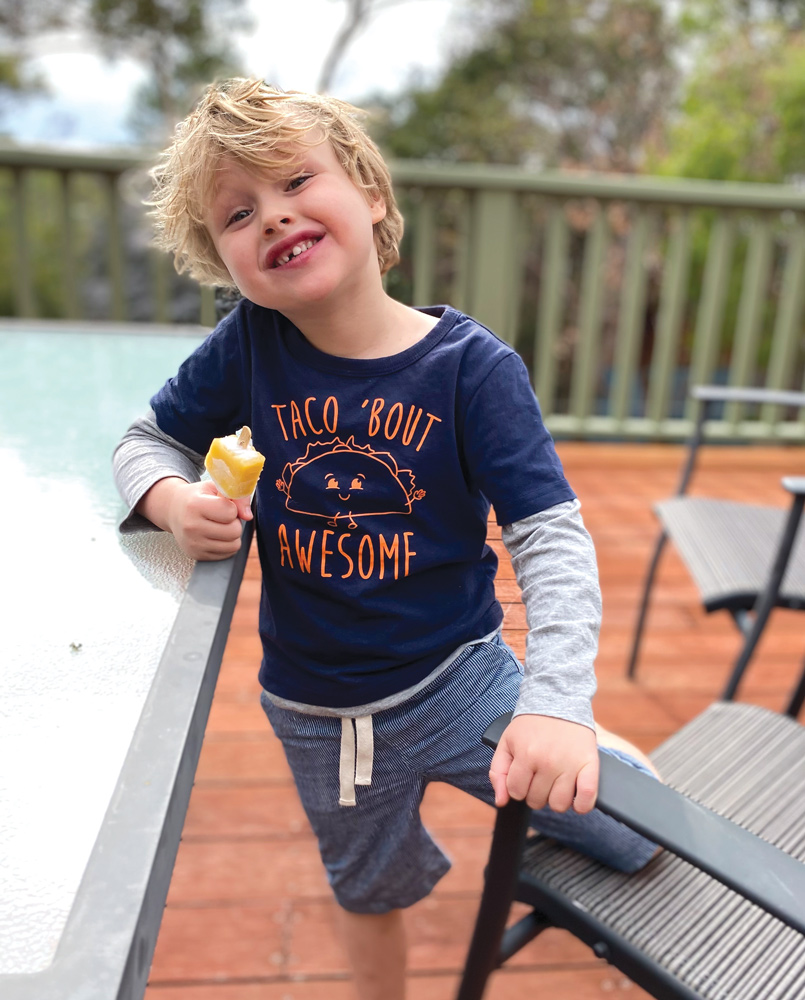 Managing food allergies in children is a balancing act for parents – trying to avoid dangerous reactions while not unnecessarily restricting diets, as Cathy O’Leary explains.
Managing food allergies in children is a balancing act for parents – trying to avoid dangerous reactions while not unnecessarily restricting diets, as Cathy O’Leary explains.
For years, the mantra given to new parents was to avoid giving riskier foods like peanuts and eggs to young babies in the belief this would reduce the risk of allergies.
But the messaging has evolved over the years, as research topped up the knowledge bank to suggest food avoidance can sometimes do more harm than good.
While parents were once advised to avoid allergenic foods in their child’s diet until the age of three, Australian guidelines were walked back in 2016 by advising parents to introduce nuts and other allergens before 12 months.
A recent study by Murdoch Children’s Research Institute suggests it was the right move after collecting data from about 2000 infants from 2018-19 and comparing the findings to a similar study 10 years earlier, under the old infant feeding guidelines.
Researchers found that the changes to the guidelines had led to a 16% decrease in peanut allergies.
However, the need for more research remains strong in Australia, which is often labelled the food allergy capital of the world, with an estimated one in 10 children developing a food allergy by the age of one.
Although many children will grow out of allergies to cow’s milk, soy, wheat and egg, peanut allergies persist into adulthood for about 75% of childhood sufferers.
Services buckle under demand
In Western Australia, food allergies are growing, putting pressure on primary health providers such as GPs and specialist allergy services, with long waiting lists for assessment.

It prompted the start of SmartStartAllergy, a project at Perth Children’s Hospital based on a successful pilot led by consultant immunologist Dr Michael O’Sullivan in partnership with Dr Alan Leeb, a GP and developer of SmartVax.
It is enlisting the help of GPs to educate parents about food allergies in infants and encourage them to report allergic reactions through the use of automated SMS technology.
Dr O’Sullivan said the parent-reported reactions to food would also help provide a clearer picture of the rates of food allergies in WA children.
It was thought 10% of children had a food allergy at 12 months of age, with about 8-9% having egg allergy, based on raw egg studies, 3% allergic to peanut and a similar number allergic to dairy.
“A larger scale, observational research project means we can better report the incidence of food allergies as we don’t have any good measures of that at the moment,” he says.
“Getting kids in and doing food challenges under supervision gives you an absolute answer, but it’s time-consuming and expensive, so we’re using a process that combines parents’ reported questionnaires and that’s done with GPs.”
Dr O’Sullivan said PCH received pilot funding through the PCH Foundation five years ago to promote what was, at the time, recent updates to infant feeding and allergy prevention guidelines to give infants peanut in the first year.
At the time few infants were eating peanuts in the first year, and the trial used a health promotion tool, via an SMS message to parents, to collect data. The pilot showed parents were more likely to follow the guidelines if they were sent the messages.
GPs as a resource
“We know that in the first year of life, an infant will see a GP more than any other health professional,” Dr O’Sullivan says. “It’s a good way to try to get a sense of what is actually happening at a community level, rather than what we see coming through emergency or specialist referral.”
He said GPs carried a lot of expertise in family medicine, and they understood their families and how anxious they could be, so that expertise was relevant for early management of food allergy.
“Rather than plucking kids out of an existing relationship with their GP who knows the family, and dropping them into a clinic as a one-off appointment and then sending them back to the GP, we want to tailor the approach,” he says.
“Sometimes the GP might just need to ask a question, other times the child might need to be referred to see a specialist.”
 Changing advice
Changing advice
Dr O’Sullivan said there was explicit advice in the late 1990s to avoid peanuts until the age of three, and egg until after the age of two, and then there was a lack of any advice for a while. The change in advice now had been taken up well, but some families were reluctant about giving infants foods like peanuts.
“If GPs get results back that show parents haven’t tried certain foods, they might have the opportunity to talk to them about that,” he said.
“The general advice is to gradually introduce the foods without any prior testing because testing can create false positives and can delay introduction of food while they’re waiting for a specialist appointment.
“Even when reactions occur, it’s still safe to try foods in young kids, because there’s been no fatalities from an allergic reaction in under two years.
“Some people worry something terrible will happen, and yes there is a risk of a reaction, but the risk of anything terrible happening is very low.”
Results next year
Dr O’Sullivan said he hoped that by early next year they would have fairly robust estimates of the rates of food allergies in one-year-olds in WA, and then expect updates every 12 months to see any trends emerging.
“As we roll out more public health interventions around allergy prevention, it would be nice to get population real-time reporting through GPs,” he said
Meanwhile, some allergy experts are campaigning to raise more awareness about potentially life-threatening allergic reactions, or anaphylaxis, though the National Allergy Strategy (NAS).
These reactions cause about 2400 hospital admissions and 20 deaths in Australia each year. Over 4 million Australians live with allergic disease, and that number is on the rise.
Costly mistakes
The NAS says three mistakes people make when responding to anaphylaxis are assuming it is not a severe allergic reaction because there is no skin rash or facial swelling; delaying the administration of adrenaline; and allowing the person to walk, even to an ambulance, after having adrenaline.
Ms Maria Said, co-chair of the NAS and chief executive of Allergy and Anaphylaxis Australia, says people need to access appropriate care at the right time and be properly diagnosed.
“We still have people at risk of anaphylaxis who go to a GP but are never referred on to see an allergy specialist, and that’s a critical issue, because when we look at fatal reactions, almost all of them are not under the ongoing care of an allergy specialist to keep tabs on them,” she says.
“I can’t stress enough how important it is for people to be referred on, even though waiting lists are long, and I think the long waits deter some GPs from referring people.
“Unless you see a specialist, you probably won’t know that, if you have asthma, you’re at a higher risk of a fatal reaction, and if you’re unwell, or drinking alcohol, and you eat something, you’re going to have a more severe reaction.
“Unless you’re an expert in the field, you won’t be aware of all the current information.”
Ms Said says she is frustrated after talking to a father whose 17-year-old son recently died from anaphylaxis.
“It’s the same story – kid not referred to see an allergy specialist, even though he’d had reactions. They weren’t severe, but he wasn’t given an EpiPen and the family wasn’t told that the next reaction could be a lot worse,” she says.
“This isn’t an isolated case. When people sometimes disclose their allergy to me and I ask if they’ve ever seen a specialist, they say no but they’re just really careful. And I say to them I’m really careful when I drive my car but that doesn’t mean I’ll never have a car accident.
“I’m not picking on GPs, and some manage these patients really well, but we need to be doing better to improve access to care.”
Dr O’Sullivan says the ultimate aim of his project was to make food allergy management as uncomplicated as possible.
“While it’s very important kids with severe allergies are safely and carefully managed, we might have created a level of anxiety around people with relatively mild allergies that exceeds what they need to be worried about,” he says.
“But if parents think their child has an allergy that needs to be addressed, it almost doesn’t matter what we think, because that’s ultimately what drives behaviour and anxiety, and diet modification.”
ED: Doctors wanting to be part of SmartStartAllergy should go to www.smartstartallergy.com.au
For the latest allergy management guidelines go to the Australasian Society of Clinical Immunology and Allergy at www.allergy.org.au/hp/anaphylaxis.
 Lincoln’s story
Lincoln’s story
Four years ago, Hayley McLean was doing everything by the textbook to reduce the risk of allergic reactions in her one-year-old son.
She and her husband Jamen Oliver had found out a few months earlier that Lincoln was allergic to dairy products after his face swelled up when he tried yoghurt for the first time. They promptly removed all dairy foods from their home.
But one day at work Hayley ate a small piece of chocolate and nine hours later when she kissed Lincoln on the forehead his whole head broke out in hives.
Worse was to come a few years later when Lincoln was accidentally given a bottle containing cow’s milk instead of rice milk when he was in daycare. Hayley is still traumatised by the event.
“I got a phone call saying something’s happened and get here straight away. They had called an ambulance, but no one had given him his EpiPen because he wasn’t really miserable, so everyone hesitated.
“He was rushed under sirens and lights to Perth Children’s Hospital. My husband was working FIFO and I had to call him and tell him, and he had to hop on a plane not knowing what he was coming home to.”
Hayley says there was a second close call at daycare when Lincoln was given a tuna sandwich and, unbeknown to the carer, the canned tuna contained dairy.
“They did give him the EpiPen straight away and it was a very different story because he was treated without delay.”
There was another incident in a restaurant which was predominantly vegan, but the grilled cheese sandwich given to Lincoln contained real cheese.
“The symptoms were different, he was quite lethargic, and his grandma had done the training and she gave him the EpiPen, but it was still another pretty intense hospital stay.”
Hayley says Lincoln, now five, is becoming aware of what he can’t eat, and if people offer him food he will often say no, he has an allergy.
He has to be accompanied to birthday parties and the family take their own food.
“Going out for the day has to be planned, we can’t just call in somewhere for lunch,” she says.
“He always has back-up clothes at school, and if he has a touch reaction, which is once every week or two, he breaks out in hives or gets puffy eyes and he has to have antihistamines and change all his clothes.”
Hayley says many people do not appreciate that allergies can mean more than an uncomfortable rash.
“They don’t realise that for some people it’s a life-or-death situation.”

